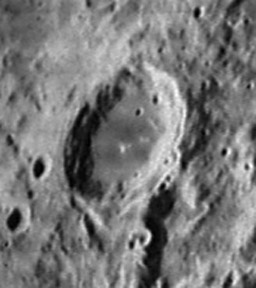Mercurius
Contents
- 1 Mercurius
- 2 Table of Contents
- 2.1 Images
- 2.2 Maps
- 2.3 Description
- 2.4 Description: Elger
- 2.5 Description: Wikipedia
- 2.6 Additional Information
- 2.7 The ESE-WNW tendency of the region surrounding Mercurius
- 2.8 Other indications of the ESE-WNW tendency in the region of Mercurius
- 2.9 Nomenclature
- 2.10 LPOD Articles
- 2.11 Bibliography
Mercurius
|
Lat: 46.6°N, Long: 66.2°E, Diam: 67 km, Depth: 3.6 km, [/R%C3%BCkl%2015 Rükl 15], [/Stratigraphy Nectarian] |
Table of Contents
[#Mercurius Mercurius]
[#Mercurius-Images Images]
[#Mercurius-Maps Maps]
[#Mercurius-Description Description]
[#Mercurius-Description: Elger Description: Elger]
[#Mercurius-Description: Wikipedia Description: Wikipedia]
[#Mercurius-Additional Information Additional Information]
[#Mercurius-The ESE-WNW tendency of the region surrounding Mercurius The ESE-WNW tendency of the region surrounding Mercurius]
[#Mercurius-Other indications of the ESE-WNW tendency in the region of Mercurius Other indications of the ESE-WNW tendency in the region of Mercurius]
[#Mercurius-Nomenclature Nomenclature]
[#Mercurius-LPOD Articles LPOD Articles]
[#Mercurius-Bibliography Bibliography]

LOIV-165-h2
Images
LPOD Photo Gallery Lunar Orbiter Images Apollo Images
Maps
([/LAC%20zone LAC zone] 28A2) USGS Digital Atlas PDF
Description
Description: Elger
([/IAU%20Directions IAU Directions]) MERCURIUS.--This formation is 25 miles in diameter. A small crater stands on the S.W. section of the wall. There is a longitudinal range in the interior, and on the E. and N.E. the remains of two large walled-plains, the more easterly of which is a noteworthy object under suitable conditions. A short distance S. is a large, irregular, and very dark marking. On the N., lies an immense bright plain, extending nearly to the border of [/Endymion Endymion].
Description: Wikipedia
Additional Information
Depth data from [/Kurt%20Fisher%20crater%20depths Kurt Fisher database]
- Westfall, 2000: 3.6 km
- Cherrington, 1969: 2.98 km
The ESE-WNW tendency of the region surrounding Mercurius
An investigation of the online WAC-mosaic in the LROC ACT-REACT QUICK MAP reveals a certain tendency of east-southeast to west-northwest arranged formations running all over the region of Mercurius and its surroundings. Even on the floor of Mercurius itself there are two elongated hills with the same ESE-WNW tendency. There is also a rather long ESE-WNW arranged "valley" which runs all the way from Mercurius J (west of Mercurius itself) to Zeno A (east-southeast of Mercurius). The central section of this long valley is touching the southern part of Mercurius' rim.
Other indications of the ESE-WNW tendency in the region of Mercurius
The two "valleys" east and west of Endymion D
The "valley" northwest of Messala C (south of Lacus Spei)
The "valley" east of Messala J
The section of Zeno's rim between Zeno and Zeno D west of it
The "valley" east-southeast of Zeno E
The elongated crater southeast of Zeno X
Nomenclature
- The [/IAU IAU] name is the Latin spelling for [/Nomenclature-Mythological%20Figures mythological figure], Mercury.
- The name was given by [/Riccioli Riccioli], although [/Whitaker Whitaker] feels that the feature so-labeled was the modern [/Lacus%20Spei Lacus Spei], and that the modern Mercurius was called Osymandies by Riccioli (pp. 213-214). Due to the ambiguities in the rendering of the limb areas of Riccioli's map, it is difficult to verify this.
- Riccioli's name Mercurius became more definitely attached to the present feature when [/Lichtenberg Lichtenberg] prepared the nomenclature index to accompany [/Tobias%20Mayer Tobias Mayer]'s published map. As reworked for [/Johann%20Schr%C3%B6ter Johann Schröter]'s book, the list also includes a Mercurius falsus attributed, there, to Riccioli but possibly an invention of Schröter or Lichtenberg. Mercurius falsus appears to be the modern [/Gauss Gauss].
- Mercurius, by then agreed to by all authorities as the proper name for the present feature, became Catalog Entry 396 in the [/Collated%20List Collated List] and in [/Named%20Lunar%20Formations Named Lunar Formations].
LPOD Articles
Bibliography
This page has been edited 1 times. The last modification was made by - tychocrater tychocrater on Jun 13, 2009 3:24 pm - afx3u2